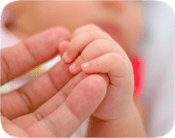Metachromatic leukodystrophy (MLD) is a disease passed from parent to child through a broken gene.
In MLD, the body can't properly make the enzyme arylsulfatase A. This leads to a loss of myelin — the special coating that protects the body's nerves.
Without enough myelin, the nerves stop working right.
Nerve damage keeps the brain from sending signals to the body, which leads to MLD symptoms.
Types of MLD
There are three types of this condition:
- Late infantile MLD. This is the most common type. It usually forms between 6 months and 2 years of age.
- Juvenile MLD. This type occurs from around age 4 through adolescence, and the disease progresses more slowly.
- Adult MLD. This late-onset MLD occurs anytime in adulthood.
Metachromatic Leukodystrophy Symptoms
MLD symptoms may start as early as 6 months or as late as 2 years.
Late-infantile MLD symptoms
Symptoms may include:
- Trouble walking, especially with lifting the feet or controlling movements.
- Impaired speech.
- Trouble swallowing.
- Muscle weakness and stiffness.
- Loss of bladder control after your child has been potty trained.
Children with late-infantile MLD often lose the ability to walk and talk within a few months of the first symptoms.
Juvenile MLD symptoms
When MLD starts later in a child's life, its progression is often slower.
Some of the symptoms of juvenile MLD may include:
- Trouble following directions.
- New problems with speech.
- Problems with behavior.
- Loss of muscle tone.
- Trouble with balance, coordination, and walking.
How Do You Diagnose MLD?
A doctor must make a diagnosis quickly if your child has any of the above symptoms.
The doctor will check your child and learn about their medical history.
Some tests your child may need are:
- Blood draws.
- Urine tests.
- MRI to look for changes in the brain. An MRI can show how much myelin the brain has. Over months or years, repeat scans can help doctors track myelin loss.
Metachromatic Leukodystrophy Treatment Options
Right now, there's no cure for MLD.
Doctors will closely follow the progression of the disease and work to offer supportive care. This is care that helps improve your child's quality of life.
Physical therapy (PT) for MLD
Children with MLD may find PT helps them move better. It can also make muscles less painful and stiff.
Our physical therapists also provide assistive devices, like walkers and wheelchairs.
Speech therapy for MLD
Speech therapy can help children learn ways to communicate and treat swallowing issues.
Our speech therapists work with nutritionists to make sure your child gets proper nutrition if they have trouble swallowing.
Medicine
Your child's doctor may also prescribe drugs to help:
- Prevent seizures.
- Manage pain.
- Get better sleep.
- Treat digestive issues.
Transplant for kids with MLD
An umbilical cord blood transplant has extended the lives of many children with MLD. It can't undo the damage done, but it may keep it from getting worse.
Transplant isn't an option for all children with MLD, but your child's doctor may discuss it with you.
Your Child's MLD Consult and Care: What to Expect
If a doctor diagnosed your child with metachromatic leukodystrophy, we want you to know you're not alone. The Center for Rare Disease Therapy (CRDT) at UPMC Children's Hospital of Pittsburgh is here to help.
To make an appointment for your child or refer a patient for MLD care, contact us by:
Here's what you can expect when you come to us for your child's first consult.
What should I expect at my child's first MLD visit?
You can expect your first visit to take from 4 hours to a few days.
Your child will have a thorough exam at the UPMC Children’s Center for NeuroGenomics (CCNG). Deepa Rajan, MD, from the CCNG will make or confirm a precise MLD diagnosis and learn how much it’s progressed.
Because we work as a team at the center, other doctors and staff might see your child during your visit.
These may include experts in:
- Genetic diseases.
- Brain diseases.
- Child development.
- Hearing.
- PT.
What are the next steps after my child's MLD visit to the Center for Rare Disease Therapy?
Before you leave, we'll talk with you about:
- The likely next steps for your child.
- Options for treating your child's MLD.
- Ways to care for your child at home to help improve their quality of life.
We'll discuss the details if we think a transplant might be a good option for your child. We want to make sure you know what the transplant entails and how you may need to prepare.
By the end of your visit, you'll have a care plan tailored to your child's MLD and needs.
We'll also schedule a follow-up visit in three months.
You'll meet our nurse practitioner. You can contact them by phone or video conference with any concerns you have between now and your next appointment.
Before you leave, please ask us about your child's MLD diagnosis, treatment, or anything else on your mind.
When should I expect the results if my child had tests at the Center for Rare Disease Therapy?
You can expect to meet with Dr. Rajan to review the results and explain the next steps during your visit.
You can also find your child's test results on MyCHP — Children's patient portal. MyCHP portal lets you manage your child's health online.
It's free to patients, parents, and guardians of UPMC Children's Hospital of Pittsburgh.
Partners in Your Child's Metachromatic Leukodystrophy Care
When a child has a rare disease like MLD, it affects the whole family.
At the Center for Rare Disease Therapy, we see each family member as our partner. The best care approach happens when we merge our MLD expertise with your knowledge of what's best for your child.









 Meet Our Rare Disease Center Patients
Meet Our Rare Disease Center Patients